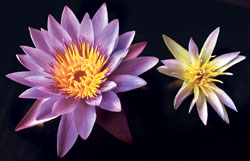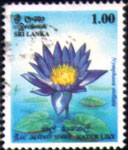Big and purple, it is proudly “propagated” as the ‘National Flower’ of Sri Lanka.
It is on the government’s official website, the stamp issued to commemorate the National Flower, the school textbooks with children looking at it and committing it to memory, posters in Sri Lankan missions abroad and even on the worldwide web with Wikipedia and many a book on the flowers of Sri Lanka following suit.
The official picture of the National Flower Nil Manel or Blue Water Lily (Nymphaea nouchali Burm. f) is wrong, says a botanist and professor of the University of Peradeniya in a stunning disclosure.
 |
| The imposter (left) and Nil Manel (right). |
This is a serious national faux pas, Prof. Deepthi Yakandawala, Professor in Botany, Department of Botany, Peradeniya Faculty of Science, points out after roaming far and wide across the country, and peering closely at hundreds of both the “right” Nil Manel and the imposter that Sri Lanka is promoting as its National Flower.
The imposter may be Nymphaea capensis, Nymphaea caerulea or even a hybrid with Nymphaea micrantha, the Sunday Times understands, with Prof. Yakandawala explaining that more study will be required to ascertain that.
The irony is that while the real Nil Manel is a “native” of Sri Lanka, the imposter which may have been introduced to the country long ago and been naturalized is neither endemic nor native, according to this Professor who is just one of two experts in plant molecular taxonomy (naming and classifying plants) and phylogenetics (the evolutionary links among different groups of organisms) in the country.
The imposter which is more widely spread than the Nil Manel which is only naturally distributed is popularly used in landscaping, says Prof. Yakandawala who carried out the research with many forays into the wild with husband Dr. Kapila Yakandawala of the Wayamba University as a collaborator and Technical Assistant Indika Peabotuwage assisting her. Her research has been partly-funded by the Ministry of Environment and Natural Resources.
This botanist who pored over the book considered the “Bible of Botany”, ‘A revised handbook of the Flora of Ceylon’ edited by M.D. Dassanayake and W.D. Clayton studied the morphological (external or physical) features of both the flowers. “The ‘Flora of Ceylon’ accurately describes in detail the Nil Manel,” she points out.
Having kept the botany colour-card against their petals, she says, Nil Manel is a pale blue while the imposter is more purple than blue.
Prof. Yakandawala studied 48 characteristics of 75 specimens each of both Nil Manel and the imposter. Her research on Nil Manel began when looking at official publications and websites the “picture did not seem right”. For somewhere, tucked into her memory was a smaller flower that she had seen as a child in the pond of the school where her mother taught in Kandy.
Curiosity galvanizing her into action, she meticulously went through the section on Nymphaea nouchali in the ‘Flora of Ceylon’, one of the Editors of which was her guru, and began her quest for the right flower to match the right picture. Her mission took her to different parts of the country and she found Nil Manel in all three zones, dry, intermediate and wet, and the imposter mainly in the dry zone. “Nil Manel grows in smaller, natural water bodies or pools while the other is abundantly found in larger tanks or wewas.”
 |
Prof. Deepthi Yakandawala |
Prof. Yakandawala contrasts the two: while Nil Manel has fewer petals, stamens, stigmatic heads, carpals, the other has more. The leaves of the two are also different.
The colour of the two is different with the Nil Manel being more blue and very pleasing to the eye as opposed to the purple of the other, she says.
This is how ‘Flora of Ceylon’ describes the colour of Nil Manel…. “pale violet or pale blue fading to a dull blue, yellowish at base”.
What are the options now? A name or flower change, the Sunday Times understands.
If we want to keep the picture, then we need to change the name of the National Flower, otherwise we should retain the Nil Manel or N. nouchali and change the picture, says Prof. Yakandawala, urging the second option.
Nil Manel is a native and it may be better to keep it as the National Flower but insert the right picture, she adds.
How did it all begin?
The National Flower and National Tree of Sri Lanka were declared following Cabinet approval way back in February 1986, the Sunday Times understands.
A three-member committee comprising Prof. Nandadasa Kodagoda and two botanists was appointed to make this crucial decision, recalls then Chairman of the Central Environmental Authority, K.H.J. Wijayadasa.
Newspaper advertisements called for suggestions from the public and there was a flood with the lotus and araliya being recommended as the National Flower and coconut as the National Tree, it is learnt.
The expert committee sifted through all this and came up with Nil Manel as the National Flower and Na as the National Tree, says Mr. Wijayadasa who prepared the Cabinet paper.
This document, of course, had no accompanying pictures.
When the Sunday Times attempted to find out what government institution was responsible for these symbols and whether the wrong picture of Nil Manel had been always there or when it had crept in, we drew a blank.
The Central Environmental Authority said it did not come under their purview, as did the Ministry of Home Affairs, the Prime Minister’s Office and the President’s Office.
It is vital for Sri Lanka to specify the National Tree, Flower and Bird in an official document along with a description and a picture, as is done for the National Flag in the Constitution. |




